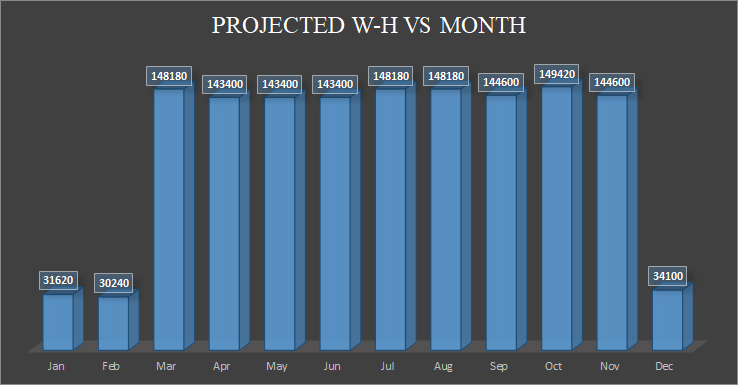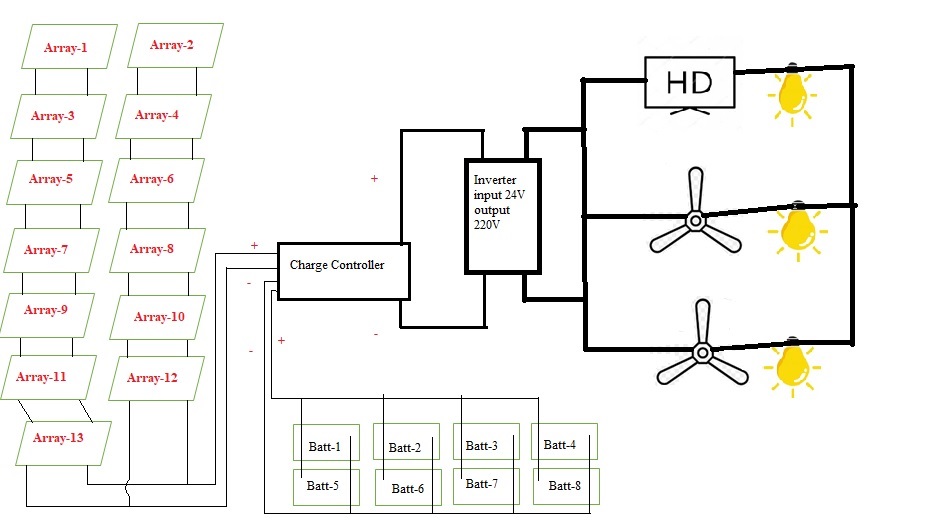Design of an Independent Solar System.
Solar system is one of the basic renewable energy system which uses the solar power to run any electrical system. It is simple but proper design is very important otherwise the sole purpose of the system may jeopardize.
So there are 8 steps to implement a proper effective solar system. Steps are follows:
1. Load determination
2. Battery selection
3. Array size and Tilt
4. Controller, Inverter/DC to DC converter selection
5. Wire, fuse and switch selection
6. Balance of system components selection
7. life-cycle cost analysis
8. Total system design
Now i will explain every steps with an example.
1. Load determination: The first and foremost important step of designing a solar system is determination of the load. The maximum, minimum and base load determination is the main step of load determination. For example: A rural home which is to be powered by a solar system has 3 energy saving light bulbs of 60 Watt each, 2 ceiling fans of 80 Watt each, and a television of 40 Watt.
if we calculate assuming usage hours we get the peak load curve and off peak load curve.
Also assuming yearly usage we can get an overall yearly distribution curve.

you can calculate for yourself using this file: Load Calculation
The total yearly load 1409.365kWh, which needs to be converted to Ah/day, by following method.
(1409.365*1000)/(365*24V)=161 Ah/day, assuming inverter’s input voltage is 24Volt. This Ah/day is required to determine the battery rating and size.
For different type of load (i.e AC or DC) total load calculation has to be done as per those individual loads rating (i.e voltage level, current rating etc).
Now as we know the requirement of the household we can go for the next step.
2. Battery Selection: The electricity generated from the solar panel must be stored otherwise during night and during rainy/winter days the system will not be able to operate the load. In short, the household wont have any power. So Battery is the main storage device to store the generated electricity and supply it when needed. The selection of Battery solely depend on the backup necessary (how many days/hours), system life time and investment.
First we have to determine the Day of autonomy (i.e how many days the system can run without sun shine), to determine the Day of Autonomy we may use this formula Dcrit = −1.9Tmin + 18.3, where Tmin= is the minimum peak sun hours, Dcrit= is the critical days of autonomy.
similarly for noncritical design Dnon = −0.48Tmin + 4.58, formula may be used to determine the days of autonomy.
As our sample design is non-critical design we may use the 2nd formula, assuming Tmin=2 hours, we get D=3.62 Days~ 4 days.
Now to determine Battery size this formula may be used:
Ah=(Ah/Day)((Days of autonomy)/(Dt*Dch*(char) )), where Ah/Day=required for the household,
Dt=temperature de-rating factor= 0.00575T+0.54, T= temperature in Fahrenheit,
Dch=Charge/Discharge re-rating factor,
disch= Depth of Discharge in fraction
Both Dt, Dch and disch are basically properties of the battery.
Now using previous Ah/Day=165Ah/day, Days of autonomy=4 Days, Dt=1, Dch=1, disch=0.8. we get Total required Ah= 825
Once the battery capacity is determined, the number of batteries in parallel
required for the system is determined by dividing the total capacity required by
the capacity of a single battery. As we are assuming 24 volt system using 12 volt battery of 200Ah we will need 825/200=4.125~4 battery (12Volt system), but for 24Volt system we will need 8 nos of 12volt -200Ah battery with parallel connection.
3. Array Size and Tilt: Before estimation of solar array size or number its very important to select the current rating of the solar panel there are different panel with different current ratings available in the market. For example we take 4.4A rating solar array. Now to estimate the number of array required we have to get the Average daily Current required for the system.
for this example we assume 165Ah/day, and average peak solar hour 3 hour, So we get average daily current rating=165/3= 55A.
Now we can get the Number of Solar Array required simply by =55/4.4= 12.5 nos ~ 13 Nos. In Bangladesh the Tilt angle is almost 20-23 Degree, which varies with site location around the world. If we have solar tracking system then the cost will increase and power generation will also increase. As we have done with solar array size we can now step forward.
4. Controller, Inverter/DC to DC converter selection: As the system has power storage and DC to AC (24V to 220V), so a controller and inverter will be required. In general if the loads are DC and at 12 or 24 volt there will be no need of Inverter or DC to DC converter. But if the load are AC then the DC power from battery must be converted to AC otherwise the load will not operate. In general AC loads operates at 220 volt so the power generated from solar system at DC 24 or DC 12 volt must be inverted to AC 220 Volt. Which can be obtained using and Inverter. Similarly if the system has DC load with higher voltage rating the a DC to DC converter may required.
But Charge controller is always required for a system where power storage is available otherwise the battery may overcharged and get damaged by the excess current flow during solar peak. To maintain optimum power stored all the time controller is must.
There are different types of Inverters and controllers are available in the market. But for our current example we will need an inverter with input of 24 Volt and output of 220 Volt.
5. Wire, fuse and switch selection: Wire, Fuse and switch selection has to be done according to the loads connected to the system. It has to be done considering every single load current and voltage rating.
6. Balance of system components selection: The total system has to be balanced as per requirements of the system. In general its about 10% of the cost of the arrays. Its basically the wiring conduits, battery compartments etc.
7. life-cycle cost analysis: Life cycle varies with different quality of the components of the system. Some solar panel cost may be low but life cycle is also poor. Some battery requires frequent maintenance and replacement while other costly battery does not. So the selection of Solar panel, Battery, inverter has to be done considering both Cost and life cycle of those components. So detail analysis is required.
8. Total system design: As all our components are selected now we can easily design the overall system layout. Which will help us to understand the system at a glance.
The layout of our current example is as follows:

Summary of the Total Solar system designed:
Loads: 3 nos 60 watt light bulbs each, 2 fan 80 Watt each, TV 40 watt
Battery storage: 4 days (i.e if consecutive 4 days no sun shines the system can run)
Array requirement: 13 array with 4.4 Amp rating current.